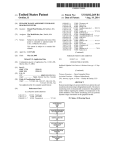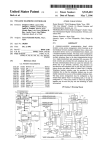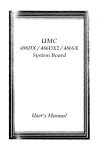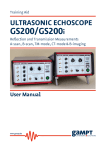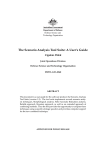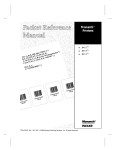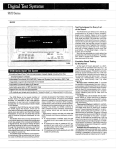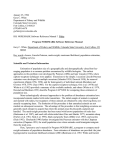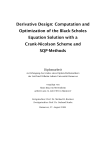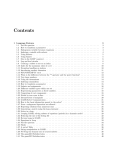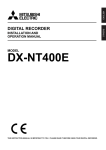Download World Bank Document - Documents & Reports
Transcript
Public Disclosure Authorized
DISCUSSION PAPER
REVISED
Report No. DRD113
Public Disclosure Authorized
Public Disclosure Authorized
Public Disclosure Authorized
HIGH LEVEL HODELING SYSTENS AND
~~TONLINEAR
PROGR.Al1MING
by
Anthony Brooke
Arne Drud
Alexander Meeraus
December 1984
Development Research Department
Economics and Research Staff
World Bank
The World Bank does not accept responsibility for the views expressed herein
which are those of the author(s) and should not be attributed to the World
Bank or to its affiliated organizationso The findings, interpretations, and
conclusions are the results of research supported by the Bank; they do not
necessarily represent official policy of the Bank. The designations employed,
the presentation of material, and any maps used in this document are solely
for the convenience of the reader and do not imply the expression of any
opinion whatsoever on the part of the World Bank or its affiliates concerning
the legal status of any country, territory, city, area, or of its authorities,
or concerning the delimitations of its boundaries, or national affiliation.
HIGH LEVEL MODELING SYSTEMS AND NONLINEAR PROGRAMMING
'
By
Anthony Brooke,·::
Arne Drud, ·::-,':
Alexander Meeraus**
Development Research Department
World Bank
December 1984
*
Consultant, The World Bank, supported by external research budget
RPO 673-06
**
Staff Members, The World Bank
ABSTRACT
The advent of high level modeling systems will make non-linear
programming (NLP) more productive.
comparison of one such system, the
'
with the traditional approach.
This judgment is illustrated by a
,'·:~neral
Algebraic Modeling System (GAMS)
The linkages between GAMS and four NLP codes
are discussed to demonstrate to code developers how more 'machine friendly'
codes will also become more 'user friendly.'
HIGH LEVEL MODELING SYSTEMS AND
NO~LINEAR
PROGRAMMING
TABLE OF CONTENTS
Abstract
1.
2.
3.
4.
5.
6.
I:n.troduction ••• ._ ........... " ...................................... 1
The Modeling Process••••••••i•••••••••••••••••••e•••••••••••••••3
GAMS and the Modeling Process ••••••••••••••••••
8
The G~~S interface to NLP codes ••••••••••••••••••••••••••••
14·
High Level Modeling Systems and NLP Code Developers •••••••••••• 21
Experience with G.A.MS ••••••••••••••••••••••••••••••••••••••••••• 22
& ••••••••••••••••
o •••
Appendix 1: GAMS/NLP Interfaces ••••••••••••••••••••••••••••••••••• 24
A. Interface with GRG2 •••••••••• ., .............................. 24
B. Interface with CONOPT ....................................... 27
C. Interface with NPSOL.~······••••••••••••••••••••••••••"••••28
References ••• ., ........................................................ 30
1.
Introduction
This paper examtnes the potential advantages of high level modeling
systems for users and developers of nonlinear programming codes, using a
particular high level system, the General Algebraic Modeling System (GM1S), as
an example.
Although nonlinear programmtng (NLP) has been under aevelopment for
many years it still has not gained the same acceptance as its cousin, linear
programming (LP), fat· at least three reasons.
First, linear models 8.re
conceptually easter to understand, and the potential user community for LP is
therefore much greater than that for NLP.
algorithms and tools cannot change.
This is a fact that even the best
Second, many model formulation and report
writing tools are available for the user of LP, but not for NLP.
A:; a result,
NLP model formulation and report generation are time consuming and expensive
-- often disproportionately so by comparison with solution costs.
Finally,
NLP codes are much less reliable than LP codes, making new applications of NLP
risky.
Most practitioners know that if an NLP model does not solve right
away, it can probably be solved if the formulation, the solution algorithm, or
the code is changed.
With traditional technology, however, the costs of
reformulation are high, and those of switching algorithms even higher.
In
summary, NLP has typically been characterized by low productivity as a result
of slow progress, high expected costs, and high risks; managers of projects
that could, in principle, use NLP have therefore in practice preferred less
sophisticated methods.
We believe that the introduction of high level modeling systems will
change this picture completely, making the tools available for model
formulation and report writing with NLP as powerful as those
av~tilable
for LP;
- 2 -
as a result, the speed and cost of model formulation under the two systems
will become comparablee
single NLP code.
A modeling system cannot change the reliability of a
It can, however, change the reliability of NLP modeling by
allowing the user to switch algorithm at no cost and to change model
formulation very cheaply.
The sections which follow will provide detailed evidence to support
the general thesis outlined above.
Section 2 describes the modeling process
and explains why current techniques are inadequate.
Specifically, in addition
to a general shortage of tools, this inadequacy stems from the fact that the
input to NLP codes has usually been designed to be machine friendly and little
has been done to make it user friendly; moreover, different codes use very
different types of input.
The position is further complicated by the
possibility that one code prefers one type of mathematical model formulation,
while another may prefer a different but mathematically equivalent
formulation.
Sections 3-6 show how GAMS, a high level modeling system developed at
t;be World Bank, tries to improve on this situation.
GAMS breaks the input
_,/
pltase into two parts.
The first part, described in Section 3, comprises the
model formulation process itself and the definition of the associated data.
GAMS uses a powerful and algorithm independent representation of model and
data, which allows the user to define large and complex models and to test
them for logical consistency in a very short time.
The second part of the
input phase, discussed in Section 4, is the translation of the user's model
representation into the input format of the NLP code.
This is done
automatically by GAMS once the user has chosen a NLP code.
GAMS knows the
- 3 -
input (and output) format of several NLP codes, and the user can switch from
one to another by simply changing a code name.
Section 3 and 4 focus on the user's problems, and the benefits he/she
can get from a high level modeling system.
accruing to the developers of NLP codes.
kinds.
Section 5 turns to the gains
These gains are of at least three
First, the productivity 1ncreases derived from NLP modeling systems
can 1ncrease the overall market for these systems' associated codes.
In
addition, use of a high level system permits the code developer to concentrate
on the
OP~imization
algorithm, and to limit his involvement with the tedious
parts •)f software development such as user friendly input/output and
docuEmntation.
Finally, once an interface has been written for a new code,
the availability of a large set of test models written 1n a high level
language will make testing of this new code easier and more thorough.
The
penalty for these benefits 1s that the input to NLP codes needs to be
standardized, so that interfaces can be standardized or at least built from
standard components.
Section 6 concludes the paper with a short description
of experience to date with the GAMS modeling system.
2.
The Modeling Process.
The process of building and us1ng models, linear or nonlinear) is
composed of five interrelated steps: model formulation, model implementation,
model solution, report writing, and model documentation.
The efficiency of
the overall modeling process depends on the techniques used in each of the
five steps, and on how well these techniques are integrated.
We will try in
the following paragraphs to cover each step and emphasize the links between
steps.
- 4 -
A mathematician may think of a model simply as a set of variables
tied together by constraints or equations.
However, a set of data, and
transformations that convert the data into model coefficients
important in practice.
We define the model formulation
a~e
proces~
just as
as that of
defining the basic data set, defining the transformations of the data that
•
create the coefficients of the model and defining the variables and the
constraints.
Note that our definition conl:ains both a procedural or recursive
part, the data transformations, and a non-procedural or simultaneous part, the
variables and the
constraints~
It is important to realize that we are
probably dealing with multidimensional quantities such as demand in different
regions for different products, production of different products in different
plants in different periods etc.
Baste
~ata,
and equations can all be multidimensional.
derived coefficients, variables,
it is also important to realize
that exceptions exist in all but the most trivial models: initial and terminal
periods differ, some plants only produce some products, and so forth.
This is
equivalent to saying that the multidimensional quantities can be sparse.
The
model formulation process must therefore rely on techniques for defining data,
data transformations, and variables and equations over multidimensional
domains, subject to exceptions or sparsity.
Our conventional algebraic
notation with subscripts and summations is well suited for this purpose, and
most models are initially defined using this notation.
The subsequent process of implementing the model on a computer can be
broken down into several linked subproce?ses: structuring and entering the
basic data, programming the data transformations, selecting the solution code,
and translating the model into the format required by the solution code.
The
translation step will usually involve writing a FORTRAN subroutine that can
- 5 -
compute the constraint values for given values of the variables.
It sometimes
involves writing subroutines for the derivatives of the constraints: for large
models it may also involve specifying a sparsity pattern.
Using conventional techniques, the FORTRAN code will be written us1ng
a mixture of two approaches: the block approach and the single equation
approach.
'
problem.
The block approach exploits the multidimensional structure of the
The code will use multidimensional arrays and will be full of DO-
loops, but it will also contain complicated constructs to handle the
exceptions; these make the code difficult to read, verify, and modify.
This
approach was used with the first GAMS-NLP interfaces; further details are
given in the appendix.
The single equation
approa~h
eliminates all the
complications of exceptions by treating each equation and variable within a
block as an individual equation or ve
~iable.
The code becomes very simple,
but also very long, and all t''e structure of the underlying model vanishes.
It is therefore just as difficult to read and verify as the block structured
code, and just as difficult to modify.
It is also much more expensive to
compile.
Some NLP codes require more than a FORTRAN subroutine that evaluates
constraints.
They may also require a sparsity pattern and/or a subroutine
that computes derivatives.
This additional input is essentially a
transformation of the information already built into the constraint
subroutine.
The user must thus provide the same information in two formats,
and in a consistent manner.
Once the groundwork has been covered, the soluti0n of the model
itself is usually straightforward.
and calling the NLP code.
It involves selecting some initial values
Difficulties arise only if the NLP code cannot
- 6 -
solve the model, aomething that happens more frequently than modelers like to
admit.
There are only three remedies.
~nether
set of initial values, for example, ones computed from the basic
data.
The simplest one is to try with
The two other approaches are to try a different NLP code, or to change
the model formulation into an equivalent one, by scaling rows or columns, for
example, and to try to solve the new model with the old NLP code.
Both these
alternatives can be very expensive since they involve redoing a great deal of
labor intensive programming in the model implementation phase.
We have
mentioned that failures are common, but we should also note that most problems
can be solved by an experienced modeler with one of the existing codes after a
few initial points and a few formulations have been tried; thus, solutions can
be obtained reasonably reliably if we are prepared to spend time and money.
After completion of the solution phase, we are now ready to produce a
set of reports.
Report writing involves accessing solution values, often both
primal and dual, performing transformations of them, and writing tables with
the transformed values.
The transformations will often involve the original
data set and/or some of the coefficients, so the report software must have
access to all this data.
The conventional technique is to write special
purpose software for report writing, using either a block approach or a single
item approach.
The remaining phase, documentation, should ideally be carried out in
parallel with the other four.
We usually think of documentation in terms of
two items, the documentation of the mathematics of the model, and the
documentation of how this model has been implemented on a computer.
Recent
papers, e.g. Gass, [8], discuss the documentation aspects of modeling, using
some very expensive modeling exercises as examples.
These papers implicitly
- 7 -
assume that conventional techniques were used for implementing the model;
under these circumstances, the issue of documentation becomes to a la· Je
extent a matter of documenting the FORTRAN code, and of setting up mechanisms
to ensure that the mathematical model documentation and the program
documentation are updated in parallel, i.e. that they represent the same
I
model.
All the work involved in conventional NLP modeling, except the
solution process itself, thus relies on software specially developed f0r the
model at hand, and the modeling process 1s therefore very labor intensive.
It
becomes also very inflexible because there is no good way of rewriting code if
necessary.
In addition, there is a significant probability that the model
defined through our FORTRAN code differs from the model we think we have
defined because of undetected errors.
We believe that NLP modeling can become a general tool only if
current technology can be made cheaper and more reliable.
This requires that
the modeler should only enter a certain piece of information into the computer
once, and that he/she should enter it 1n a format that is natural to
him/her.
The computer should then transform information as needed.
Such a
procedure has several advantages: it improves the productivity of the modeler
by avoiding repetitions, it eliminates many transformation errors caused by
manual operation, and it makes documentation much easier.
It also eliminates
the documentation of FORTRAN code, and can make the computer
~nput
self
documenting.
We call a computer program that accepts user friendly model
definitions and performs all the necessary transformations to interface with a
solution code a modeling system.
The next section decribes one such modeling
- 8 -
system, GAMS, and show haw it can solve a number of the problems outlined
above.
3.
GAMS and the Modeling Process
This section briefly describes some of the key features of the GAMS
language.
The description 1s intended to illustrate with examples some of the
most important features of GAMS and how they can increase the prod\lctivity of
modeling; the reader who is interested in further details is referred to
Kendrick and Meeraus [11] and Meeraus [13].
Models become large not because they contain many different concepts,
but because the concepts they describe are repetitive and defined over large
sets, e.g. demand at many locations or production in many plants.
It is
therefore important that a modeling system has facilities for defining sets,
and for defining data, data transformations, variables and equations over sets
or cartesian products of sets.
Below are two examples of GAMS set
definitions.
SET FA FACTORS OF PRODUCTION I LABOR, CAPITAL I
SC PRODUCTION SECTORS
I AGRICULT, MANUFACT, SERVICES
I;
FA and SC are the names of the sets, LABOR and CAPITAL, and AGRICULT,
MANUFACT, and SERVICES are the elements of the two sets, and the strings
FACTORS OF PRODUCTION and PRODUCTION SECTORS are (optional) documentation
text.
•
- 9 -
Data can be entered 1n simple tabular form:
TABLE
FACIN(FA,SC}
FACTOR INCOME IN DIFFERENT SECTORS
CAPITAL
LABOR
AGRICULT
MANUFACT
SERVICES
1200
2000
2900
1500
2300
Here the FA and SG following FAGIN indicates that FAGIN is defined
over the domains of factors and sectors.
column labels of the table
~re
GAMS will check that the row and
members of the proper sets, i.e. that there are
no spelling errors, and it will check in later occurrences of FAGIN for proper
use of indices.
Note that sets in GAMS are deliberately unordered; the row
labels are ordered differently in the SET statement and the TABLE statement,
but GAMS interprets the data by matching the labels and not the positions.
Once the basic data
h~ve
been defined with SET and TABLE statements,
it is easy to transform them into the coefficients needed in the model.
1s done us1ng assignment statements like those below.
This
(A PARAMETER in GAMS :s
used to collect and name exogenous data values.)
PARAMETER
SECTIN(SC)
TOTAL INCOME IN EACH SECTOR
FCSH(FA,SC)
FACTOR SHARES OF INCOME IN EACH SECTOR;
SECTIN(SC) = SUM( FA , FACIN(FA,SC) );
FCSH(FA,SC) = FACIN(FA,SC) / SECTIN(SC);
As well as these conventional algebraic operations, GAMS defines set
operations such as un1ons and intersections, and operators over cartesian
products like SUM, PROD, MIN, and MAX, making it easy to define aggregations
and matrix products, and to perform other frequently used transformations.
Using the basic data and the derived coefficients we can now define
the variables and equations that make up the model.
In the example below,
- 10 -
output Q is modeled with a Cobb-Douglas production function (QO and TOTFACT
are assumed to be parameters defined elsewhere).
VARIABLES
Q(SC)
PRODUCTION IN EACH SECTOR
IN(FA,SC} INPUT OF EACH FACTOR IN EACH SECTOR
POSITIVE VARIABLES Q,IN
EQUATIONS
PRDF(SC)
FACT( FA}
PRODUCTION FUNCTION IN EACH SECTOR
FACTOR AVAILABILITY;
PRDF(SC} •• Q(SC) =E= QO(SC) * PROD( FA , IN(FA,SC)**FCSH(FA,SC} );
FACT(FA) •• SUM( SC , IN(FA,SC) ) =L= TOTFACT(FA};
The careful reader will have noticed that one of the sectors,
'SERVICES', did not use one of the factors, 'CAPITAL'.
The corresponding
variable, IN('CAPITAL' ,'SERVICES'), could therefore be removed from this
equation.
This and other types of exceptions frequently occur in large
models, and a consistent and convenient way of representing them is crucial
any modeling system.
In GAMS, exceptions are defined with a$ or 'such that' operator.
Applied to the FACT equation above it yields
FACT(FA) •• SUM( SC$FCSH(FA,SC) , IN(FA,SC) ) =L= TOTFACT(FA);
This means that the summation
of the set FA for which FCSH(FA,SC)
~s
~s
carried out only over the elements
nonzero.
The $-operator can also be
applied to the domain over which an equation or an assignment statement is
defined.
It is not necessary to put an exception into equation PROF since
GAMS recognizes that the term IN('CAPITAL', 'SERVICES')**O has the constant
value of 1 and that IN('CAPITAL', 'SERVICES') can thus be removed from the
equation PRDF('SERVICES').
~n
- 11 -
Exceptions can also be handled through the use of subsets.
Assume
that only the goods produced by the agricultural and manufacturing sectors are
exported.
We can create a subset of the export sectors and define certain
parameters, variables and equations over this subset:
SET SCE(SC) EXPORT SECTORS I AGRICULT, MANUFACT I
PARAMETER
EXO(SCE)
BASIC EXPORT QUANTITY
ETA(SCE)
EXPORT ELASTICITY
PW(SCE)
WORLD PRICES FOR TRADED GOODS
VARIABLES
EX(SCE)
EXPORT FROM THE TRADED SECTORS
PD(SC)
DOMESTIC PRICE OF GOODS BY SECTOR
EQUATIONS
EXD(SCE)
EXPORT DEMAND EQUATION FOR TRADED
SECTORS;
EXD(SCE).o
EX(SCE) =E= EXO(SCE)
ETA(STC);
*
(PW(SCE)/PD(SCE))
**
Notice that PD is defined over the set of all sectors, but only
referenced over the export subset in the export demand equation.
A model in GAMS 1s defined as a collection of equations and the
variables they contain.
To start optimizing we simply state the objective,
its direction, and the generic problem class.
Particular codes can be
selected using OPTION statements.
MODEL EXAMPLE I PROF, FACT, EXD, other equation names
OPTION NLP = nlp-code;
SOLVE EXAMPLE USING NLP MINIMIZING objective;
I;
Notice, that the definition of the model is completely independent of
the solution code.
above.
The only place it is mentioned is in the OPTION statement
This is very important; if the solution attempt fails with one
algorithm, an easy switch to another is made by changing this one statement.
- 12 -
The execution of the SOLVE statement entails several verification and
testing steps and then, if all is well, the model implementation and model
solution steps mentioned in section 2.
GAMS will first analyze the model
symbolically and determine if it is a member of the class of models mentioned
on the SOLVE statement.
GAMS will then create the problem representation
1n
the correct format, design a solution strategy, compile the created FORTRAN if
necessary and transfer control to the NLP code.
After the solution code has
terminated, GAMS will read the output and translate it back into GAMS notation
for storage in the GAMS data base.
from the NLP code.
Normally the user will not see any output
Only if it fails in an unexpected way will code specific
output be returned to the user.
The report writing step 1s straightforward. The solution values were
saved in the GAMS database by the SOLVE statement, and they can now be used in
further data manipulations, often using the DISPLAY statement to design and
print tables.
Four quantities are saved in the database for each variable:
the level value, the lower bound, the upper bound, and the marginal value;
four similar quantities are saved for each equation.
The four values of
variable IN can be referred to as IN.L, IN.LO, IN.UP, and IN.M, respectively.
References to the four quantities associated with a variable or an
equation can be on either the right or left hand side of an assignment, i.e.,
IN.L can be used to compute values for a report after a model has been solved,
but it can also be assigned a value, e.g.
IN.L(FA,SC) = FACIN(FA,SC)
Assignments of level values are used to define initial values for an
optimization, and all the data manipulation machinery of GAMS is available.
- 13 -
It is therefore easy to compute good initial values and to try alternative
sets of these values.
The use of the current level values as initial values
for an optimization has an added advantage:
if we want to solve a second
related model, GAMS will automatically use the optimal values from the first
model as initial values for the second.
In some cases it is useful to solve
on2 or more relatively simple problems, perhaps linear, to find a good
starting point.
The use of current level values as inital values lS also
extremely useful if an NLP code cannot solve a model.
It is easy to try to
solve the model with another code, starting from the intermediate solution
found by the first code.
All the user has to do lS to specify the name of the
new code, and GAMS can take care of the rest.
reformulations of certain parts of a model.
This can also be nseful after
The values of the variables will
automatically be used by GAMS as long as their names are the same.
Documentation is the final step ln the modelling process.
The only
thing that has to be documented is the GAMS source input; all other parts of
the model are temporary data structures and can be ignored.
GAMS has been
designed to encourage the modeler to document t·he model as it is developed.
All sets, parameters, variables, and equations can have documentation texts
associated with them, and the documentation is kept in the CAMS database and
displayed each time they are printed.
The GAMS source input can be used as
the complete documentation of the model, especially if the modeler makes a
conscientious effort to make source text clear and easy to understand.
The
development of a model in GAMS is similar to that of a scientific paper:
several drafts are usually needed before the message has been presented in a
clear and concise way to make it as easy as possible for the reader.
models developed in the World Bank now u3e the GAMS input as the final
Several
- 14 -
documentation and include it in the final reports, as in for example Brown et
al, [2], Choksi et al, [3], and Kendrick et al [10).
4.
The GAMS interface to NLP codes.
One of the design philosophies of GAMS is that models should be
represented in an algorithmically independent way.
This is, of course, useful
only if links exist to many different optimization codes, and preferably to
codes that are built around different principles.
At present GAMS can
communicate with four LP systems and four NLP codes, and more links, both
generic and specific, will be added.
So as to add these 1n an efficient and
reliable way it is desirable to build on common components.
In order to
define some reasonable common components this section provides a summary
overview of the codes we have already integrated, and d
interfaces.
~cribe
the existing
More technical information on the interfaces can be found in the
appendix.
Table l gives an overview of several characteristics of the four NLP
codes that can be used with GAMS.
The ~odes are GRG 2 (Lasdon et.al. [12]),
NPSOL (Gill et.al., [9]), MINOS 5.0 (Murtagh and Saunders, [16]), and CONOPT
(Drud, [7]).
The remainder of this section provides additional information
about the entries in the table and the interface components.
The execution of a SOLVE statement always begins with some common
steps.
GAMS checks that all sets, parameters, and equations used in the model
have been defined and it checks that the model belongs to the class of models
that can be handled by the particular NLP code.
The restrictions are that
equations must be differentiable functions of the variables and that variables
cannot be binary.
The user can disable the differentiability test by defining
-
Table 1:
:ILS -
SOME CHARACTERISTICS OF THE FOUR NLP CODES
.CURRENTLY ACCES:SIBLE THROUGH GAHS
Code
GRG2
CONOPT
NPSOL
MINOS
~
Characteristics:
Algori. thm Type: 1/
Jacobian representation:
Sparse
Equations ordered
Variables ordered
Non linear elements
distinguished
Subroutines:
Constraints and
objective separated
Linear terms
1n functions
Numerical. derivatives
Numerical derivatives
computed sparse 4/
Name to index
mappings 5/
Miscellaneous
Stand-alone system
Syst·em can be modified
System controls memory,
error recovery and file:
buffers
GRG
GRG
SQP
PAL
No
No
No
Yes
No
No
No
Yes
No
Yes
Yes
Yes
No
Yes
No 2/
No 2/
No
No
Yes
Yes
Yes
Yes
3/
Yes
Yes
No
No
Yes
Yes
No
Yes
No
Yes
Yes
Yes
No
No
Yes
Yes
Yes
No
Yes
No
No
Notes:
1. The algorithm types are: GRG - Generalized Reduced Gradient, SQP Sequential Quadratic Programming, and PAL - Projected Augmented
Lagrangian.
2. NPSOL considers all Jacobian elements in the nonlinear equations
nonlinear, and MINOS considers all Jacobian elements occuring in both
nonlinear variables and nonlinear equations to be nonlinear.
3. Linear terms can either be included in the FORTRAN subroutine or
the coefficient can be defined through the MPS file.
4. Numerical derivatives are computed 'sparse' if several columns of
the Jacobian can be computed in one call of the constraint subroutine
(see Coleman and More, [4]).
5. Both MINOS and CONOPT define a sparse Jacobian through an MPS-type
file, i.e., through names of variables. The subroutines use variable
indices. CONOPT allo~s explicit mappings from names to indices, MINOS
does not.
- 16 -
the model as a discontinous NLP (DNLP), but this must be done explicitly ~nd
should only be undertaken by experienced users.
Almost all general purpo1;e NLP codes define the nonlinearities of a
problem through one or more subroutines that appear to the code as black
boxes.
The NL;) code delivers one vector of variable values to the subroutine
and expects one or more vectors with constraint and/or derivative values
back.
The inner functioning of the subroutine is of no concern to the
optimize~r and GAMS can do anything it finds convenient inside the subroutine.
The first interface built was the one to GRG2.
GR1G2 does not
distinguish between linear and nonlinear equations or between linear and
nonlinear variables; it does not need sparsity information but it can compute
numerical derivatives.
We decided to rely on the numerical derivatives
computed by GRG2 1 and thus had only to create a FORTRAN subirOutine that could
compute constraint values for given values of the variables"
uses the block approach referred to in Section 2.
The subroutine
The complications arising
from exceptions and sparsity of multidimensional variables and equations are
discussed in some detail in Section A of the appendix.
The second interface was to CONOPT.
CONOPT is a sparse GRG code
requiring an MPS-type file to describe the sparsity pattern of the Jacobian.
Each Jacobian element must be classified as linear or nonlinear.
The values
of the linear entries can be entered in the MPS file or evaluated by
subroutine calls.
CONOPT can compute numerical deri~atives and it takes
advantages of sparsity in this computatio~ using methods sinnilar to those in
Coleman and More [4], so the number of function evaluations needed to compute
derivatives is comparable to the maximum number of nonlinear Jacobian entries
in any row.
Again, we used derivatives computed by differencing and decided
- 17 -
to include the
subroutine.
line~ar
components of the constt·aints in the FORTRAN
The interface then breaks down into the following tasks: write a
FORTRAN subroutine to evaluate constraint values, and write an MPS file in
which each Jacobian element 1s merely classified as linear or nonlinear.
The
code for the first task was derived from the GRG2 interface, but modifications
/
were necessary to create the sparsity pattern and to check for exceptions
caused by particular data values, such as multiplication by zero.
The
linearity or nonlinearity of Jacobian elements was determined on a block basis
only, e.g., for all IN variables in all PRDF equations as one block, by
analyzing the internal GAMS code.
The technical .aspects of the analysis are
explained 1n Section B of the appendix.
The first two interfaces were built for the original machine specific
CDC versJ.on of GAMS.
This was designed for high performance on large linear
models, and the NLP links were built using as many components of the LP
framework as possible.
GAlJiS.
The aim was to get quick and cheap experience with NLP
These linksi were very successful, and GAMS is currently used with more
non-linear problems than linear ones.
GAMS has now been rewritten to be
machine independent, and the design of the new system pays much more attention
•'
to the needs of non-linear codes.
numerical derivatives.
In particular we decided to eliminate
We no longer use block written code to specify non-
linearities, but rather single equation specifications.
We are also no longer
writing FORTRAN but instead employ symbolic instructions which are interpreted
(and which could easily be replaced by machine code for performance).
NPSOL
was chosen as the first code to be linked with the new system because it does
not require sparsity information and is therefore easier to work with, and
because it uses a sequential quadratic programming algorithm that has recently
- 18 -
been highly recommended.
(Schitkowsky, (17]).
There are three important
differences between the requirements of NPSOL and the other fully allocated
code, GRG2.
First, NPSOL handles linear equations separately: they must be
last and they must be defined by a matrix rather than a subroutine.
Second, NPSOL cannot compute numerical derivatives.
function must be written in a separate subroutine.
easy to handle.
And third, the objective
The first difference is
\
The LP component of GAMS can analyze equations for linearity
and it finds the values of the derivatives in the same way as in a matrix
gene~ator.
The difference due to the separate treatment of the objective 1s
essentially a bookkeeping problem and is also easily handled.
We are
therefore left with only one new difficulty in this interface, the
derivatives.
We have implemented a routine that creates internal GAMS
instructions for the derivatives based on the principle of point derivatives
and on repeated use of the chain rule.
This code is then evaluated in the
same way as the code for the constraints.
The point derivatives take full
advantage of intermediate values from the constraint evaluation and the
resulting code is therefore quite efficient.
It is more complicated to create
derivatives in block mode because of the possible exceptions involved; this
was one of the reasons for experimenting with a single equation approach.
We
expect that GAMS will ultimately decide automatically whether to use block or
single equation codes, and that it will switch modes depending on the problem
structure.
Technical details can be found in section C of the appendix.
The most recent link 1s between GAMS and MINOS 5.0.
demanding than the other codes.
MINOS is more
It requires that variables be sorted so that
nonlinear ones appear first, and that the FORTRAN subroutine should compute
only those parts of the nonlinear constraints that depend on the nonlinear
- 19 -
variables.
The order of variables is no problem.
GAMS uses mapp1ng vectors
to get from the vector of variables in the NLP code to the variables as GAMS
sees them, and this mapping vector can sort the variables in any order.
The
split of constraint elements into a linear and a nonlinear partition is more
difficult.
(
It requ1res two passes over the model because the classification
of a variable as linear or nonlin@ar is global to the model and not local to
the equation.
The first pass determines which variables are nonlinear and the
second removes the terms that depend on linear
variables~
Although MINOS can
compute numerical derivatives we decided not to used this feature, but used
point derivatives as in NPSOL.
The preceding paragraphs have discussed the ma1n components of the
interfaces, the generation of nonlinear function values and derivatives, and
the sorting and partitioning of data structures.
The rema1n1ng questions are
how to move initial values from GAMS into the NLP code, how to move solution
values back again, how to take care of error recovery, and how to pass control
between the two systems.
Moving initial values from GAMS to GRG2, CONOPT, and NPSOL is
straightforward.
All these codes simply receive a vector of variable values
in their ordinary input and start from there.
MINOS is slightly more
complicated, since the variables must be classified as basic, superbasic, or
nonbasic at either bound.
Moving information back is more systems specific.
For the codes using block written FORTRAN (GRG2 and CONOPT) GAMS does not know
which variables have been eliminated.
The solution is therefore written back
in the same partial order in which GAMS presented the rows and columns to the
code.
By encoding name strings GAMS 1s then able to associate each solution
record with the appropriate entry 1n the GAMS data base.
With NPSOL and MINOS
- 20 -
n~me
matching is not needed because the loops have been unrolled by GAMS
itself and all empty single rows or columns have already been eliminated.
We have taken great care to classify all possible termination states
that are detected by GAMS when reading the output file from the specific NLP
system.
We all know the disappointment when an output says "Division by zero
- Abort''; we want to make sure that this type of message is not seen by the
modeler.
First, GAMS makes sure that a syntactically incorrect model is never
passed to the NLP code.
Second, we have assured that the subroutines GAMS
creates cannot cause an abort.
We check for division by zero and recover from
errors in mathematical functions caused by undefined operations.
These
execution time errors are then reported back to the modeler with information
on where in the model the error occurred; the modeler can then decide if the
model is wrong, or if the error was simply caused by the lack of some
appropriate bounds.
Execution errors in the NLP code itself are reported as
such with an encouragement to submit the example to the code developer for
further study.
Some of the NLP codes are set up as subroutines, and they could in
principle be called directly from GAMS us1ng what Drud [16] called an internal
interface.
This possibility 1s not available in. all cases, however, notably
not with commercial LP systems.
an external interface.
We have therefore decided to use what we call
GAMS creates all the necessary information in a set of
files and calls the NLP code through a procedure at the operating system
level.
(In a multitasking environment we could spin of£ a subtask and let
GAMS wait for its completion.) The last task of the procedure is to give
control back to GAMS, and GAMS can then read
code.
th€~
output file from the NLP
Apart from the fact that this approach is the only one available in
- 21 -
some cases, it has several advantages.
It limits the use of memory (unless
overlay structures are used), and only the code that is actually used is
loaded.
More importantly, this approach makes it very clear where errors
occur, and consequently makes it easier to find them.
The intermediate files
can be captured and examined, and smaller diagnostic jobs can be run from
them.
Most important of all, code development or maintenance does not disrupt
the rest of the system.
5.
High Level Modeling Systems and NLP Code Developers.
The first sections of this paper described advantages that modelers
could derive from a high lev~l modeling system.
This section briefly notes
some of the potential benefits for researchers at the other end of the NLP
world - the developers of NLP codes.
As the use of modeling systems 1ncreases and users with non-linear
applications become more productive, the market for non-linear codes will
1ncrease.
Much of this increase will come from users who have hitherto
remained with linear formulations because of the high cost of converting
existing data representations.
A non-linear code that is accessed only
through a modeling system is also smaller and less cumbersome than a
traditional stand-alone code.
Detailed and elaborate input data checking and
attempts at recovery are not needed, nor are 1:omplex outpu
~outines.
In
MINOS 5.0 we were able to eliminate about 30% of the code because we use our
own input routines, which we know will never encounter a syntactically
incorrect problem representation.
shorter and easier to write.
User documentation will also be much
The other big advantage to be obtained from a
high level modeling system is the availability of a wide selection of test
- 22 -
problems of all sizes.
These help not only to test the code under
development, but also to compare it to other established codes.
A standard
library of 60 published models is already available for GAMS, and more are
being added.
··I
Interfaces to modeling systems are not always simple to build and
their creation requires specialized expertise.
During the com1ng year the
I
GAMS team expects to define ways of standardizing the input to NLP codes with
the goal of delivering the components of an easy 'do-it-yourself' approach to
interfacing codes.
6.
Experience with GAMS.
GM~S
1982.
has been available for LP models since 1980, and for NLPs since
It has been used in the World Bank and at collaborating research and
teaching institutions by people with widely differing experience in
mathematical programm1ng, mostly for solving problems in policy analysis,
economics, or engineering.
substantial.
The benefits to these users have been
The modeler is certainly more productive.
In many cases an
economist has been able to avoid employing a programmer to translate algebra
into the machine representation, thus maintaining direct control of the
project while still producing timely results.
Perhaps more importantly the
details of a modeling effort are now more readily accessible to others, and
the traditional question about 'what really happens in this model' can be
answered.
GAMS has also been found very useful 1n teaching.
Models set up and
solved by students have typically been small, because understanding and
implementing the data structure for complex models is a tedious and
- 23 -
specialized task.
GAMS and its library of models permits students to
concentrate on the model and not on the details of its implementation, and to
experiment with formulation or data changes on models large enough to be
interesting.
Finally, it
r
Bank
alor~
LS
worth noting, some usage statistics.
15 projects currently use GAMS.
In the World
Non-linear problems range up to
700 equations and now outnumber linear problems.
The GAMS system is accessed
by World Bank users about 50 times on a normal weekday.
- 24 -
APPENDIX 1:
A.
GAMS/NLP Interfaces
Interface with GRG2
This appendix describes the first GAMS/NLP interface that was
developed, that to GRG2.
As we saw in Table 1, GRG2 does not need much
information about the problem, and to make the task even easier we decided to
let GRG2 compute all derivatives.
The task was therefore essentially to
create a FORTRAN subroutine, called FCOMP, that for a given vector of
variables could returrt a vector of constraint values.
The conceptual
components of this FORTRAN subroutine are:
1.
Variable Mapping.
GRG2 does not know that GAMS thinks of the
problem in terms of different blocks of variables; it only knows a linear
sequence of variables, X(l), X(2),.,,,X(N).
Once this vector is received by
FCOMP it must, at least conceptually, be decomposed into the blocks of
variables that GAMS uses.
2.
the equations.
Constraint Evaluation.
FCOMP must now compute the residuals of
It is written with outer loops for the equations, and inner
loops for SUMs and PRODs.
Parameter values are picked up from a data area
within FCOMP, and the values of the variables are picked up from the
decomposed input vector.
The execution itself is done in much the same way as
in the execution system of GAMS.
3.
Constraint Mapping.
the output vector.
Save the residuals or constraint values in
Again, GAMS thinks of the constraints in terms of blocks
but GRG2 only knows a linear sequence of constraints, G(l), G(2), ••• , G(M),
and the results of step 2 must, at least conceptually, be mapped into G.
)
- 25 -
There are several difficulties involved in implementing the
conceptual steps above.
1.
The key ones are:
The blocks of GAMS variables are naturally placed after each
other in GRG2's X-vector.
It is not enough, however, to Jefine the start
within X of each block of GAMSs variables and then to compute addresses within
(
the blocks.
GAMS variables need not be defined over the full cartesian
product of its index sets.
The variable IN(FA,SC) in the model in section 3
is an example; only five out of the possible six variables are actually in the
model.
FCOMP must therefore keep an explicit mapping from the cartesian
product of the index spaces (from the s1x possible variables) into the actual
positions in X (into the five variables actually used).
2.
Some variables and parameters are indexed over one set in one
part of the model and over a different set, e.g., a subset, somewhere else 1n
the model.
An example is PD 1n equation EXD above.
GAMS must necessarily
perform the index loops over the union of the sets because the variable
mappings and the parameter addresses must have a global nature.
then be handled as exceptions to the large set.
Subsets must
The only alternative would be
to have different mappings for the same GAMS variable at different locations
1n the model.
Implementation can now be broken down into 5 steps:
1.
Find the dimensions of the model.
A dimen~;ion of a model 1s a
set consisting of all elements that are related 1n one way or another.
The
model components described in section 3 have two dimensions, a sector
dimension and a factor dimension.
The dimensions are generally determined by
observing the use of the basic sets of a model; whenever one set is used 1n
the same index position as another set in a reference to a parameter or
- 26 -
variable, then the two sets must represent the same type of information and
belong to the same dimension.
Repeated use o£ this rule generates the
dimensions.
2.
Define all sets as subsets of their dimensions and create
vectors of subset indicators.
Replace all references to sets by references to
\
subsets of the corresponding dimensions.
3.
Set up the exogenous data for the model in multidimensional
arrays defined over the cartesian products of the relevant dimensions.
4.
Create the FCOMP subroutine and compile and load it with GRG2.
Before we pass control to GRG2, execute FCOMP 1n special set up mode.
mode uses arrays of indicators for all variables and equations.
This
The
indicators are initially set to 'notused', and during the setup execution the
indicators are set to eused' each time a variable or an equation is
referenced.
5.
Squeeze all variables and equations marked 'notused' out of the
model and create mapp1ng arrays for variables and equations.
mappings in all later calls of FCOMP.
Use these
Call GRG2 and constraint evaluations
can begin.
The link back to GAMS is also straightforward.
We have added a
special binary output file to GRG2 containing both primal and dual information
in much the same format as supplied by commercial LP systems.
GAMS reads this
file, maps the GRG2 variables and equations into GAMS variables and equations,
and saves the solution 1n its database.
- 27 -
B~
Interface with CONOPT
This section describes the components that had to be added to the
GRG2 interface in order to handle the extra requirements associated with
sparsity in CONOPT, and to implement 'squeezing' based on exogenous data
values as well as the logical 'squeezing' used with GRG2.
The first change was to write two versions of FCOMP, a special setup
(
vers1on and a simpler execution time version.
The setup version has extra
code that detects which variables and equations are ustd and stores the
equation/variable identifiers as a pair each time a variable is referenced.
We simultaneously evaluate constant expressions and do not write entries if
the coefficient is guaranteed to be zero.
This information 1s sorted,
duplicates are removed, and the Jacobian structure is ready for output 1n a
MPS file.
The second addition had to do with detecting which Jacobian elements
were linear and which were nonlinear.
The internal representation of
expressions in GAMS relies on a stack machine, and it is fairly easy to
analyze linearity within this framework.
Each operand on the stack is
classified as constant, linear, or nonlinear.
c
When an exogenous value 1s
pushed on the stack it will be classified as constant, and when a variable 1s
pushed on the stack it will be classified as linear.
When an operation 1s
applied to one or two operands on the stack, the result will be classified on
the basis of the operation and classification of the operands.
constant
~nd
Addition of a
a linear operator will create a linear operator, and
multiplication of two linear operators will create a nonlinear operator.
Whenever an operand on the stack becomes nonlinear, all variables that
- 28 -
contributed to this operand are classified as nonlinear variables in this
equation, and the corresponding Jacobian elements are nonlinear.
The analysis of which Jacobian elements are nonlinear can be done on
a block level, i.e., we can determine whether IN(*,*) appears nonlinearly in
PROF(*), or on an individual equation level, i.e. we can determine whether
IN( 1 LABOR', 'SERVICES') appears nonlinearly in PRDF('SERVICES').
The block
)
approach is much faster since most models have several equations in each block
of equations and several variables in each block of variables.
may, however, classify a few linear elements as nonlinear.
IN('LABOR' ,'SERVICES') in equation PRDF('SERVICES').
This approach
An example is
The power is exactly one
in this case, so the term is linear, even though the overall block must be
classified as nonlinear.
The CONOPT interface uses a block approach and this
information is needed to generate the two FCOMPS.
C.
Interface with NPSOL
This section describes the features that are unique to the NPSOL
interface, ioe., the single equation approach ·and the derivatives.
The single equation approach is quite simple.
GAMS loops over the
indices of the constraints and creates a separate constraint for each
combination.
All loops within each constraint, e.g., loops associated with
·.l.
SUMs and PRODs, are unrolled, all computations that only depend on parameter
values are performed, and products with zeros, logarithms of one, expressions
to the power one, and all exceptions are used to remove terms.
The result is
a constraint with references to variables with known indices and references to
constants, tied together by simple operators only.
- 29 -
The derivatives are based on this simplified constraint expression.
As described in Section B of this Appendix, GAMS uses a stack oriented
representation of the constraint expressions.
parallel to the function values.
The derivatives are computed in
For each operator on the stack, GAMS
remembers the numerical value of its derivatives with respect to all
(
variables, and it knows which of them are zero, one, another constant or
variable.
When a constant is pushed on the stack all derivatives of the
operator are zero.
When a variable 1s pushed on the stack all derivatives are
zero except the derivative with regard to the variable that was pushed; this
derivative is 1.
When an operation is applied to one or two operands on top
of the stack all derivative are computed using the chain rule.
The derivative
of a sum is the sum of the derivatives, and the derivative of a product, e.g.,
u*v, is u'*v+u*v', where
1
denotes derivative.
Since GAMS knows which
derivatives are zero and one it can eliminate additions of zero and products
of one; the resulting set of nontrivial instructions created by GAMS is quite
compact.
The internal GAMS code was converted· into a F0RTRAN subroutine for
GRG2 and CONOPT.
Here we have chosen to write the code into a file and
interpret it in the model subroutine.
The subroutine is model independent and
(
we can therefore create an absolute program with the optimizer and the
interpreter, thereby saving such fixed costs as those of creating FORTRAN
code, compiling it, and linking it to the optimizer itself.
We do extensive
work preprocessing the code to be interpreted, including hardwiring of all
addresses or indices, and the speed of the interpreter has turned out to be
impressive.
Most optimizations use less than 10 percent of the overall
optimization time in the interpreter, and a model has to be very complicated
before the time ratio exceeds 40 percent.
- 30 -
REFERENCES
[1]
J. BISSCHOP and A~ MEERAUS, ''On the development of a General Algebraic
Modeling System in a Strategic Planning Environment", Mathematical
Programming Study, 20 (1982) 1-29.
[2]
M. BROWN, A. DAMMERT, A. MEERAUS, and A. STOUTJESDIJK, "Worldwide
Investment Analysis, The Case of Aluminum'', ~orld Bank Staff Working
Paper, 603 (1983) 168p.
(3]
A. M. CHOKSI, A. MEERAUS, and A. STOUTJESDIJK "The Planning of Investment
Programs in the Fertilizer Industry", John Hopkins University Press,
(1980) 333p.
[4]
C. F. COLEMAN and J. J. MORE, "Estimation of Sparse Jacobian Matrices and
Graph Coloring Problems", SIAM Journal of Numerical Analysis, 20 (1983)
187-209.
[5]
A. DRUD and A. MEERAUS, "CONOPT, A System for Large Scale Dynamic
Nonlinear Optimization, User's Manual", Technical Note 16, Development
Research Center, World Bank, (1980) 70p.
[6]
A. DRUD, "Interphasing new solution algorithms with existing modeling
systems" Journal of Economic Dynamics and Control, 5 (1981) 131-149.
[7]
A. DRUD, "CONOPT - A GRG Code for Large Sparse Dynamic Nonlinear
Optimization Problems", Mathematical Programming, (forthcoming).
[8]
S. I. GASS, K. L. HOFFMAN, R. H. F. JACKSON, L. S. JOEL, and P. B.
SAUNDERS "Documentation for a Model: A Hierarchical Approach"
Communications of the ACM 24 (1982) 728-733.
.
[9]
E. P. GILL, W. MURRAY, M. A. SAUNDERS, and M. H. WRIGHT, "User's Guide
for SOL/NPSOL: A P•rtran Package for Nonlinear Programming", Department
of Operations Research, Stanford University, (1984) 34p.
[10] D. KENDRICK, A. MEERAUS, and J. ALATORRE, "The Planning of Investment
Programs in the Steel Industry", John Hopkins University Press, (1984)
310p.
[11] D. KENDRICK and A. MEERAUS, 11 GAMS, An Introduction", mimeo, Developwent
Research Department, World Bank, (1984).
[12] L. S. LASDON, A. D. WAREN, A. JAIN, and M. RATNER, "Design and Testing of
a Generalized Reduced Gradient Code for Nonlinear Progcamming", ACM
Transactions on Mathematical Software, 4 (1978) 34-50.
[13] A. MEERAUS, "General Algebraic Modeling System (GAMS), User's Guide
version 1.0 11 , Development Research Center, World Bank, (1982).
- 31 -
[14] A. MEERAUS, "An Algebraic Approach to Modeling", Journal of Economic
Dynamics and Control, 5 (1983) 81-108.
,.
[15] B. A. MURTAGH and M. A. SAUNDERS, "A Projected Lagrangian Algorithm and
its Implementation for Sparse Nonlinear Constraints", Mathematical
Programming Study 16 (1982) 84-117.
[16] Bo A. MURTAGH and M. A. SAUNDERS, "MINOS 5.0 User's Guide", Technical
Report SOL 83-20, Department of Operations Research, Stanford University,
(1983) 114p.
(17] K. SCHITTKOWSKI, "Nonlinear Programming Codes", Springer-Verlag Lecture
Notes in Economics and Mathematical Systems, 183 (1980).




































